Video games and visions of death
One cannot look away.
Death is a given, and that's doubly true for video games. And when death comes, it tends to come in force. Who among us can claim we haven't, at some point in our gaming career, meandered through plains sprinkled with corpses, or waded through rivers of blood past bobbing human remains? If video games are to be believed, corpses are more gregarious than the living. They flock to gruesome sites of executions, torture and massacres, hang themselves from nooses, impale, flay, contort or dismember themselves into bloody bouquets for us to gawk and shudder at in passing.
Games have long indulged in an aesthetic of gory excess that is extreme even by the standards of horror films and heavy metal cover art. Whether horror or history, fantasy or sci-fi, larger-than-life death has invaded many of the most popular genres in games. There's the cartoony grim-dark of Doom, with its colourful and gleeful grotesques of bodies torn to shreds by demonic invaders; Bloodborne with its cataclysmic visions of human bodies petrified, dissolved, reconfigured; or Hellblade with its psychologised quasi-historical horror of 'dark age' barbarity.
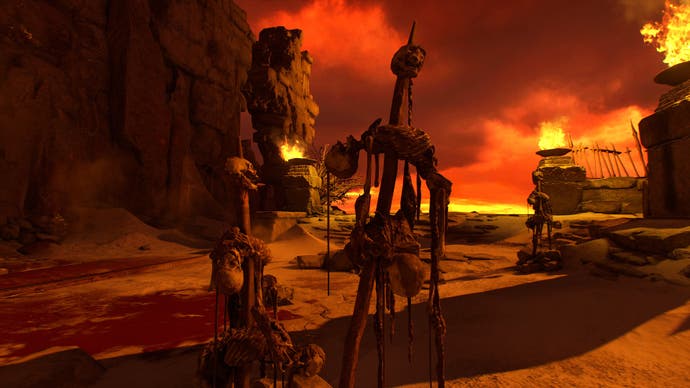

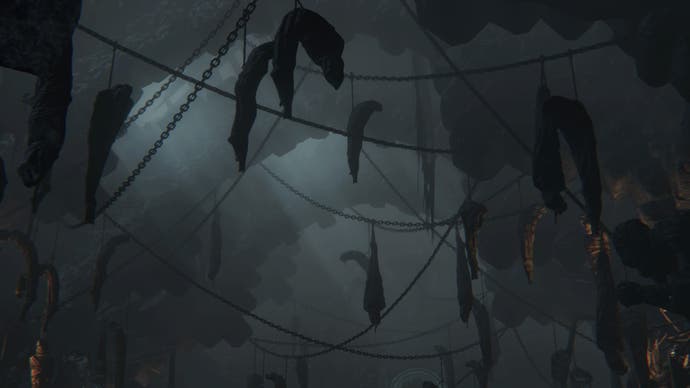

This is just a tiny sample of games that revel in transgressing taboos around death, suffering and the human body. Despite wildly differing tones and intentions and the vast gulf between, say, the goofy, icky edginess of Doom and the high-minded seriousness of Hellblade, they all share a deep-seated fascination with quasi-apocalyptic vistas deeply marked by pestilence, rot and death.
Jaded and overexposed as we have become, we often move through these carefully arranged kaleidoscopes of bodily annihilation as a matter of course. Doom guy has more urgent things to do than to stop and contemplate the sheer scale of gruesome devastation all around him. Bloodborne's amoral hunter is very much a part of his vicious and decrepit environment and unlikely to consider the abnormality of heaps of corpses by the wayside.
There's a terrible irony at play here, of images of atrocity becoming so codified and ubiquitous that they often lose their power to affect us. Depending on from which angle you look at it, these corpse-scapes run the gamut from the pleasant chill of quaint Halloween theme park rides to reminders of the incomprehensible horrors of Auschwitz or the Khmer Rouge Killing Fields.
Are games' aesthetics of death a hollow and sensationalist attempt to shock that only serves to desensitise? Before we judge those games too harshly, it's worth reminding ourselves that the tradition of horrific images of mass death predate violent games, heavy metal and horror films by many centuries. Medieval paintings and illuminations rarely shied away from bone-chillingly voyeuristic illustrations of war, punishment, martyrdom, the Last Judgement, or the fires of hell. In 1633, the Thirty-Years-War inspired Jacques Callot to document "The Great Miseries of War", a collection which includes horrific scenes such as mass hangings. Francisco Goya followed a similar creative path with his "Disasters of War" (1810-20), whose prints depict acts of mutilation and dismemberment. The works of modern dark surrealists like Francis Bacon or Zdzisław Beksiński are full of more ambiguous, but no less horrifying images of twisted, broken and grotesquely transfigured flesh and bodies.

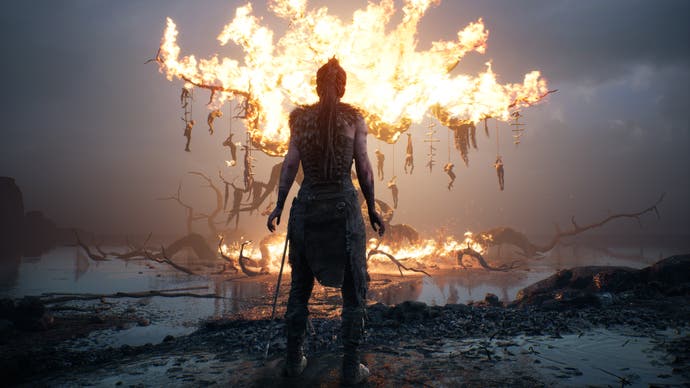
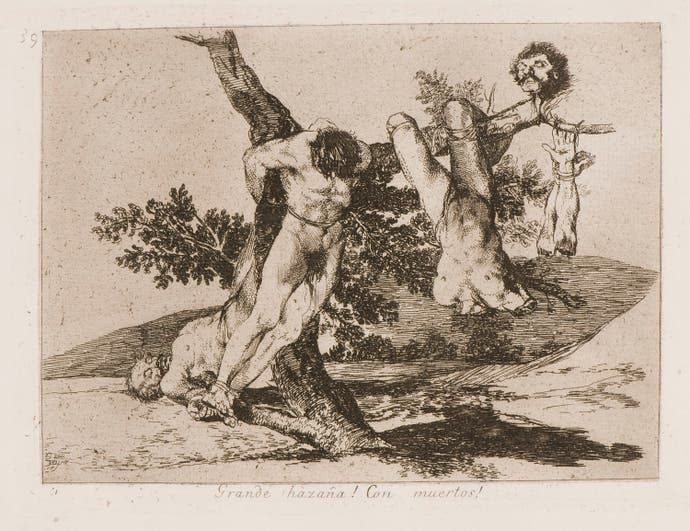


One of Goya's prints is entitled "No se puede mirar", or "One cannot look". Ironically, with this kind of image, the opposite is always equally true: one cannot look away. Like the proverbial train wreck, there is something about large-scale catastrophes that is spell-binding and entrancing precisely because it is too horrifying to look at.
Most of these images aren't primarily titillating or pornographic. Some, like the prints of Callot or Goya, document the atrocities of war in an unflinching and unheroic manner, and make a condemning political statement about the nature of war and the human capacity for cruelty. Even the fantastical paintings of Bacon or Beksiński, less overtly political, are deeply marked by real-world horror. Their work is overcast by the long shadow of the Holocaust. The incomprehensibility in the face of the new kinds of industrialised atrocities of the 20th century finds expression in dystopian landscapes, screaming, distorted faces, and masses of bodies disfigured beyond recognition.
Video games have long been in denial of their unavoidable political dimension, which makes it unsurprising that the aesthetics of death we find in most games are devoid of obvious references to a world beyond the screen. They share with art a fundamental, morbid fascination with broken bodies, but often shy away from diving deeper into our fears.
Kingdom Come: Deliverance is worth mentioning because of its ambition towards historical realism. Coming face to face with the aftermath of a massacred Bohemian town is distressing due to its aesthetic realism and the fact this kind of sight is not overused within the game. Still, its initial impact is entirely subverted by Kingdom Come: Deliverance's reliance on the tired RPG trope of the 'massacred hometown as catalyst for revenge plot'. Here, the shock value of massacred bodies is little more than a cheap attempt to imbue a stale plot with instant emotional urgency.

Another, even more common approach to death is at least more honest. Games such as Doom make no excuses for their bloody vistas. They are there to be gawked at, as titillating adornments and flourishes in the level design. There may be a gleeful kind of horror, but there is no pathos. Contradictory to its subject matter of extreme violence in literal hell (read more about Doom's conception of hell here), Doom is unconcerned with pain, not even a purely physical one. Neither Doom Guy nor the demons show any signs of being able to feel pain, and everybody else is clearly long dead. Despite skeletons seemingly still screaming out in death, Doom is a fantasy of a post-pain world that has discarded death, fear and suffering and left it to rot in the cesspits of blood and flesh we so often dash through without ever being touched or weighed down by it.
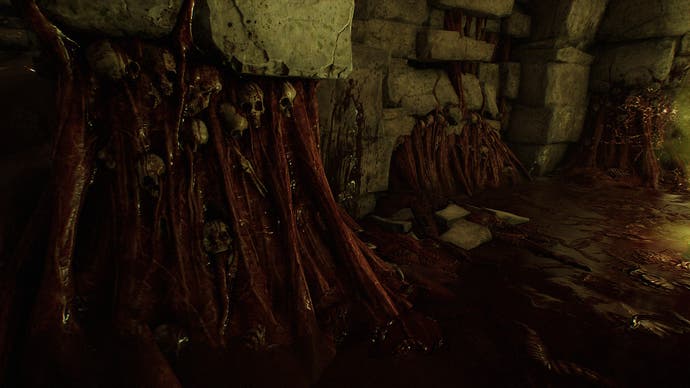


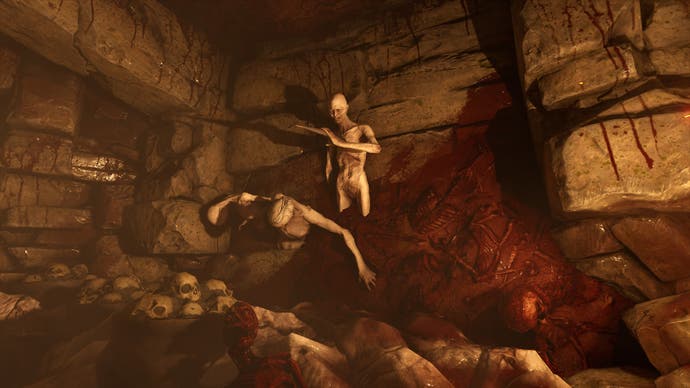
On the surface, Bloodborne may appear similar. Here, too, we struggle against an apocalyptic world strewn with the remains of its former inhabitants. And yet, both horror and pain play their parts. The world of Bloodborne is full of pathetic suffering, but it's a bestial, animalistic kind of pain. The human body, Bloodborne tells us, is malleable and ill-defined. In keeping with its Gothic inspiration, the partition between human and animal is fragile, but there's also a postmodern body horror that resonates with Beksiński's work. Human bodies are constantly being reshaped by forces that conjoin, distort, dissolve and petrify. (Read more about Beksiński's influence on Bloodborne here.)


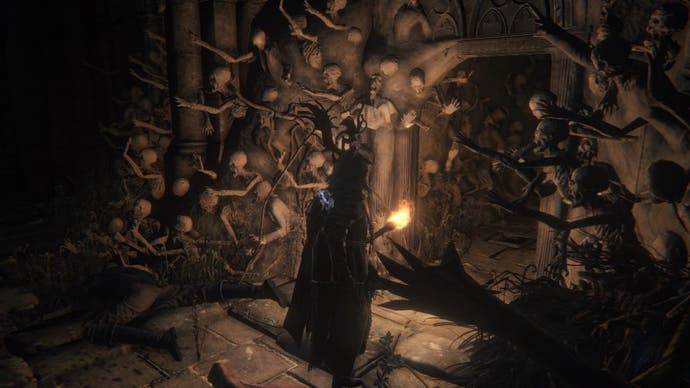
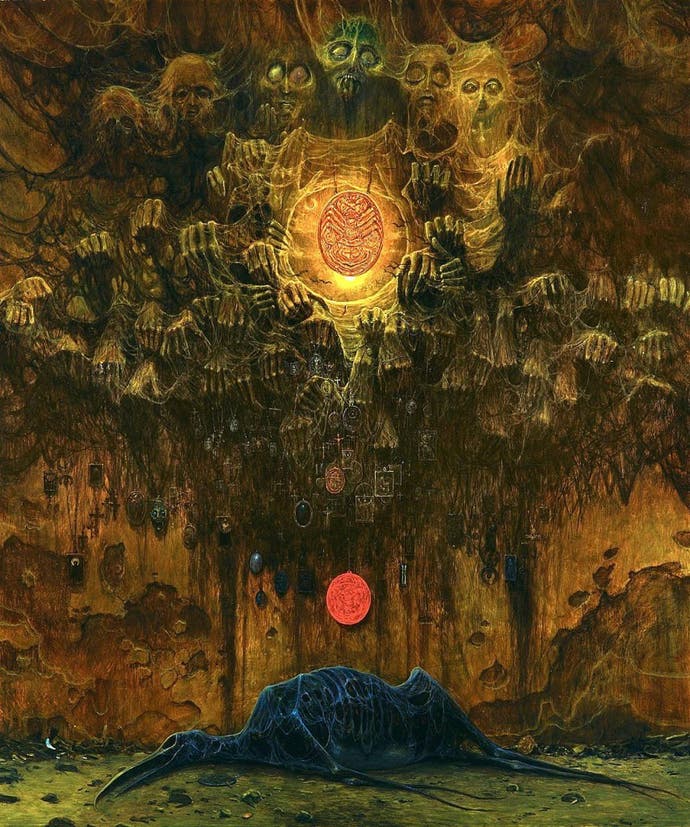
A handful of games explores the intersection between aesthetics of death and psychological pain and trauma. Here, piles of bodies aren't to be taken literally, but function as metaphors or insights into an individual character's state of mind. In Hellblade, Senua is haunted by visions of Viking brutality, people burnt alive, impaled, hanged or blood-eagled. Pain, both physical but also mental, is inextricable from its disturbing aesthetics. These sights not only stand in for actual violence but are also a way for Senua to make sense of her intimate yet apocalyptic struggle against her personal demons.
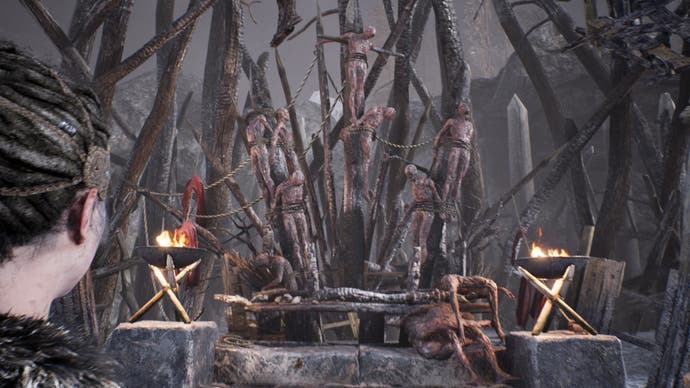
The Taiwanese horror game Detention also deals with trauma in the aftermath of violence, but its approach is even more abstract and metaphorical. Despite being a horror game, Detention uses images of death and gore sparingly and never for shock value. In one scene, we see protagonist Ray standing in front of a bloody river carrying the bodies of the dead. The bodies are distant and indistinct, and fit well into the surreal, nightmarish tone of the game. Similar to Hellblade's bodies, these corpses are a metaphor, not only for Ray's mental struggle and guilt, but also for the devastating consequences of the political oppression and persecution that took place during the so-called White Terror in Taiwan. As such, Detention is one of very few games that employ the aesthetics of death to openly engage with political subject matter.

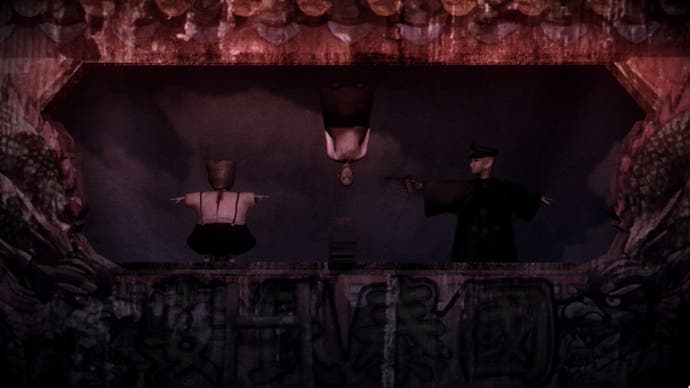
Humans have always been obsessed with death and the strangeness and horror of the corpse, and video games are no exception. The possibility of a human body without the presence of a human spark; the fragmentation and decay of something that throughout our lives we learn to perceive as indivisible and whole. The aesthetics of death in games magnify this obsession to apocalyptic proportions. Even in the most gratuitous cases, there's an ambiguity at work, a strange tension between the need to look and an unwillingness or inability to actually comprehend what we're looking at. One cannot look. One can't help but look. And so one does both.

